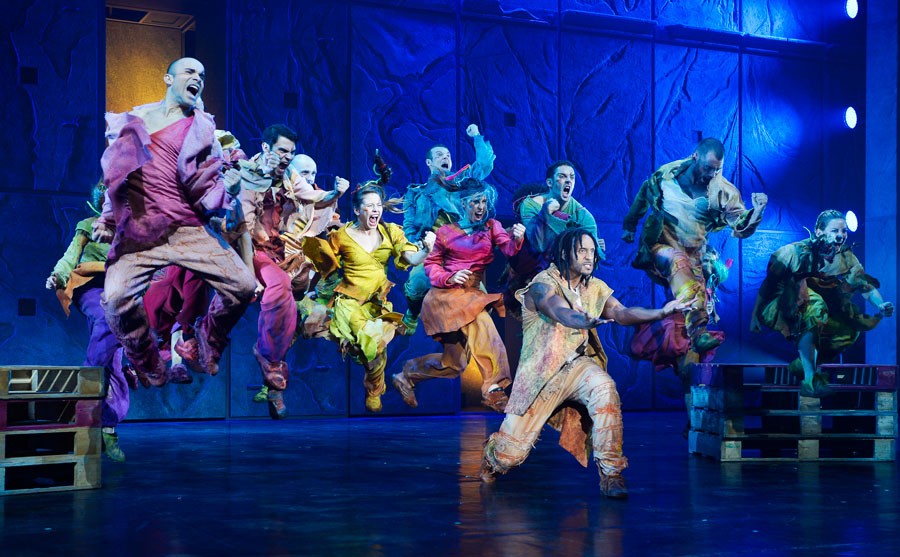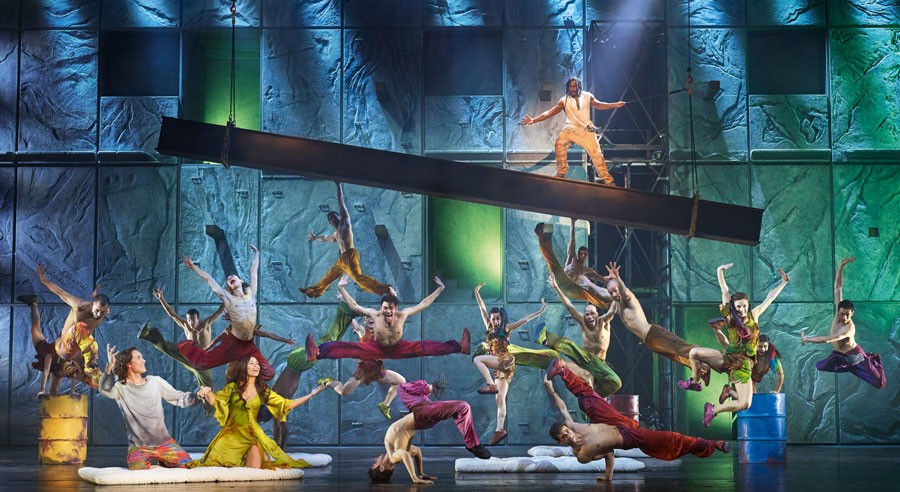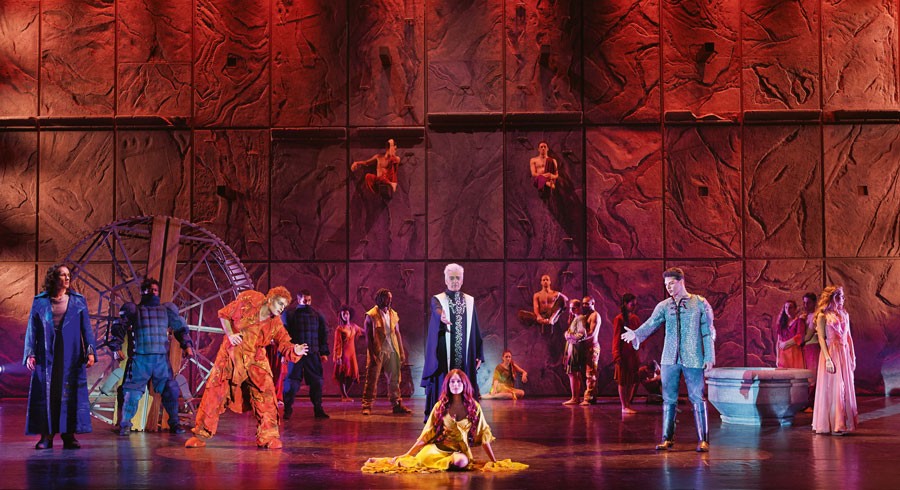NEWS TICKER
REVIEW: Notre-Dame de Paris, London Coliseum ✭✭✭✭
Published on
January 26, 2019
By
julianeaves
Julian Eaves reviews Notre-Dame de Paris which was playing at the London Coliseum for a limited run of performances this week.

Clopin (Jay) and the chorus of Notre-Dame de Paris. Photo: Patrick Carpenter Notre-Dame de Paris
London Coliseum
23rd January 2019
4 Stars
It is a famous fact that the magnificent gothic cathedral church of Notre-Dame de Paris on the Ile de la Cite took 200 years to build. This almost equally monumental musical spectacle about its celebrated hunchbacked bell-ringer has so far been running for just one-tenth of that time. However, to judge from the audience reaction at its recent visit to the Coliseum, it may well be with us for a long time to come and its run may well one day equal the duration of the construction of its illustrious forebear.
Based on Victor Hugo's melodramatic story, this show tells the simple but affecting tale of the deformed Quasimodo's tragic love for the gipsy girl, Esmeralda, complicated by her amorous entanglements with no fewer than three other men (go, girl, go!), and it was here in London in an English translation housed at the Dominion for a year and a half, shortly after its launch at the end of the Nineties (in the aircraft-hangar-like Palais des Congres). While it is a sung-through rock(-ish) opera, it is a far cry from the dramatically urgent 'Les Mis', and should not be approached in the same sort of way. It is, in fact, a sequence of pretty static set-piece 'chansons', stand-alone songs that can be heard and enjoyed on their own. This is unsurprising, of course, when you consider that the composer, Richard Cocciante comes from a background in (French) pop music. The show, therefore, seems rather like an extended medieval version of The Eurovision Song Contest, and one where ONLY France has been allowed to enter songs: from a francophone point of view, possibly an ideal situation!

Angelo Del Vecchio (Quasimodo) and Hiba Tawaji (Esmerelda). Photo: Alessandro Dobici
Luc Plamondon's texts are written in a combination of French and Quebecois (the lead villain, Frollo, is here played by its originator, the Manitoban, Daniel Lavoie), and - frankly - they do sound an awful lot better in the original, even though Jeremy Sams has done an elegant and faithful English translation for the surtitles (you could glance at these every now and then, but you really didn't have to follow them: the stage action was simple beyond belief and very, very, very easy to follow). With a French-speaking cast singing in their own language, this was a treat for musical purists. However, it did on more than one occasion feel that the characters, instead of sporting Caroline van Assche's quasi-15th century togs, or striking poses against Christian Raetz's brutalist grey set, could have been even more at home perched on narrow high stools and singing at each other with the aid of silver pencil mics in a TV variety show of, perhaps, 40 years ago?
In fact, the whole kind of TV spectacular ethos might well have done something to improve upon Martino Mueller's wriggly and rather a repetitive choreography. Each one of the songs is really conceived as a single entity and their collective effectiveness is not, actually, enhanced by being presented as if they are all of a piece. Far from it. In the true spirit of French chansonnerie, each individual unit captures - perfectly, I might add - a very specific and particular mood. The more the lighting designer, Alain Lortie, or the director, Gilles Maheu seemed to grasp this, the more meaningful the show became.

The cast of Notre-Dame de Paris. Photo: Alessandro Dobici
Meanwhile, the cast were a visual as well as a vocal adornment to the production. Hiba Tawaji, Lebanese, gave a lush performance as the doomed gipsy girl: with not a hair out of place, she survived poverty and died in prison looking never less than utterly gorgeous in a kind of flouncy Dior outfit later replaced by an alternative kind of woolly housecoat. As one of her lovers, captain of the guard, Phoebus, the spellbindingly beautiful Martin Giroux, looked remarkable in a sort of Paco Rabanne chainmail top (with off-centre front zip fastener) over a snugly fitting pair of black jeans. You get the idea? And so were all the others presented with the same refined couture sensibility. Lavoie was stately in a stiff Karl Lagerfeld'ish ensemble; Quasimodo - the wonderful baritone, Angelo Del Vecchio, imported from (perhaps once French-controlled?) Italy, was wackier in a colourful, Jean-Paul Gaultier sort of way; and the narrator figure, the poet Gringoire (a superlative turn by Richard Charest - who had brought quite a fan club to the house) was more of a traditional, Yves Saint Laurent-type figure; Alyzee Lalande gave us a very Jane Birkin sort of girl as Fleur-de-Lys, in one of Givenchy's more impromptu moments, perhaps; and then Jay was a more muscular, rough-edged Thierry Mugler kinda guy. They looked - as well as sounded - just great!
There was a chorus, too, who were wrapped up in scraps of this and that which never detracted from the leads' garments; and then, in a discreet nod to sensuality, a squad of five muscle-packed, rubber-boned super-acrobats frequently appeared topless, stunning all with their remarkably chiselled and powerful torsos and phenomenal moves. Actually, their tumbling was the dramatic highlight of the production, whose remarkably austere sense of stage action put one more in mind of the rigours of Corneille than the sensuous opulence of the Lido.

The cast of Notre-Dame de Paris. Photo: Alessandro Dobici
The same cannot be said for the music. All hearts were won over by the irresistibly melodic powers of the band (mostly a pre-recorded backing tape, offering us the splendid arrangements of Cocciante himself and also Serge Perathoner and Jannick Top); ostensibly they were all under the metronomic baton of tape-follower Matthew Brind, who kept his handful of live-action ENO orchestra strings company in the nearly deserted pit.
This is a particular type of entertainment; not to everyone's taste, certainly, but then - what is? For a week's run at the Coli, however, it definitely draws crowds sufficient to fill the place, and what a lovely bunch they were: ultra-cosmopolitan, an international crowd making the point, yet again, that London is a world cultural capital. I had no idea what to expect when I went to see this show, and I'm so glad I went. I was charmed and enchanted, disarmed and seduced by it. How French!
© BRITISHTHEATRE.COM 1999-2024 All Rights Reserved.
The BritishTheatre.com website was created to celebrate the rich and diverse theatrical culture of the United Kingdom. Our mission is to provide the latest UK theatre news, West End reviews, and insights into both regional theatre and London theatre tickets, ensuring enthusiasts can stay up to date with everything from the biggest West End musicals to cutting-edge fringe theatre. We are passionate about encouraging and nurturing the performing arts in all their forms.
The spirit of theatre is alive and thriving, and BritishTheatre.com is at the forefront of delivering timely, authoritative news and information to theatre lovers. Our dedicated team of theatre journalists and critics works tirelessly to cover every production and event, making it easy for you to access the latest reviews and book London theatre tickets for must-see shows.